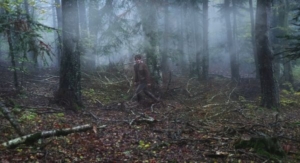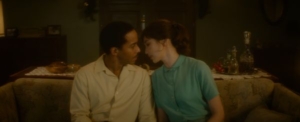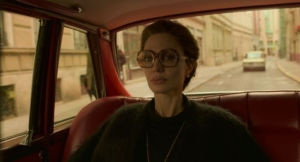
Geppetto (voiced by David Bradley) and Pinocchio (Gregory Mann) in Guillermo del Toro’s Pinocchio (Netflix)
![]() Chances are most viewers’ memories of the titular marionette trace back to Walt Disney’s groundbreaking 1940 film. Every subsequent Pinocchio adaptation has seemingly tried to recapture that Disney magic with mixed results, doing little to innovate Pinocchio’s story beyond replaying the cartoon’s greatest hits—including Disney+’s own poorly received live-action remake from earlier this year. So, while a new Pinocchio movie co-directed by Guillermo del Toro seems like a no brainer, the question remains: What can he bring to the story that’s new? By shifting the filmmaking from traditional animation to stop motion, then transplanting the puppet’s journey into 1930s Fascist Italy, he and his team have created perhaps the best Pinocchio adaptation since Disney’s original.
Chances are most viewers’ memories of the titular marionette trace back to Walt Disney’s groundbreaking 1940 film. Every subsequent Pinocchio adaptation has seemingly tried to recapture that Disney magic with mixed results, doing little to innovate Pinocchio’s story beyond replaying the cartoon’s greatest hits—including Disney+’s own poorly received live-action remake from earlier this year. So, while a new Pinocchio movie co-directed by Guillermo del Toro seems like a no brainer, the question remains: What can he bring to the story that’s new? By shifting the filmmaking from traditional animation to stop motion, then transplanting the puppet’s journey into 1930s Fascist Italy, he and his team have created perhaps the best Pinocchio adaptation since Disney’s original.
In this variation of Carlo Collodi’s original story, it’s not joy but rather heartbreak and war that brings the perpetually carefree Pinocchio into existence. His creator/surrogate father Geppetto (voiced by David Bradley) is a shell of the woodcarver he used to be after losing his son, Carlo, during World War I. The loss continues to haunt Geppetto for two decades until one night, drunken and enraged, he chops down a tree with a significant connection to Carlo and fashions a long-nosed puppet from its wood. Right on cue, Wood Sprite (Tilda Swinton) arrives and breathes life into Pinocchio (Gregory Mann), and instructs a chatty cricket, the intellectual dandy Sebastian (Ewan McGregor), to teach him right from wrong.
For the most part, Guillermo del Toro’s Pinocchio stays loyal to the core beats of his literary and animated predecessors, even while reinventing a supporting player or two. We see the puppet lured away from attending school by devious circus owner Count Volpe (Christoph Waltz), befriending local boy Candlewick (Finn Wolfhard), and ultimately escaping from a large sea creature’s belly as in most retellings. But it’s the outside world that’s different, or rather too familiar, as Pinocchio comes alive in a fascist state fully beholden to Mussolini. Some denizens of Geppetto’s village are more zealous than others, like Candlewick’s true believer dad, Podestà (del Toro regular Ron Perlman), but even Geppetto greets his neighbors with a Fascist salute, signifying how perversely normal this lifestyle has become. The time relocation works because Pinocchio’s rambunctious, carefree behavior runs counter to totalitarianism’s expectations for young boys, let alone for a sentient marionette.
Most Pinocchio media treat his dishonesty and gullibility in a negative light, as a cautionary tale with sympathetic yet ironic punishments. Hence the infamous growing nose. But del Toro frames his hero as a positive rejection of the world around him. He’s a kind soul, struggling to understand right from wrong, and his actions are juxtaposed against the indifference of toxic, pro-Fascist men who only value Pinocchio for profit or the promise of an undying wooden soldier. They’re similarly abusive figures—Volpe to his monkey assistant Spazzatura (Cate Blanchett), Podestà to his son—under the belief that real boys are obedient, militant, and devoid of weakness. Never rebellious. By leaning into his defiant nature, Pinocchio’s refusal to follow authority becomes a symbol of childlike independence in opposition to the conformists around him.
It shouldn’t need to be said that this movie is gorgeous. Produced with assistance from ShadowMachine and the Jim Henson Company, Pinocchio’s stop-motion universe is at once removed from Disney aesthetics and distinctly loyal to its spirit. This is a very lived-in world, full of earthy textures, expressionist architecture, and religious motifs that help foreground our protagonist’s dilemma at every turn. Even the occasional musical number benefits from the art direction, offering a lively, energetic bounce to Pinocchio’s movements whenever he’s performing on stage. The songs aren’t necessary—at times they feel like the lone carryover from the Disney legacy—but some of the lyrics provide levity that balances out del Toro’s disconcerting geopolitical landscape.
Being Guillermo del Toro, there’s plenty of weird creatures too, not just Sebastian the cricket, who continually winds up the butt of dark slapstick injuries whenever Pinocchio snubs his warnings, but the portrayal of death itself. This is where the story’s fairy-tale nature really comes alive, treating viewers to a surreal landscape of coffins, irritated rabbit employees, and a sphynx-like administrator (also voiced by Swinton) with some degree of control over Pinocchio’s unique gift. It’s a world that, ironically, embraces the same dark vibe of classic Disney, but in less traumatizing ways than 1940’s Pleasure Island sequence.
To watch Pinocchio is to see old made innovative again, a classic story told with a fresh coat of paint. It’s not just a hit for Netflix, it’s a passion project that pays off in full. After all, there are few stories del Toro loves more than the outlandish misfit who discovers love and family.
















Leave A Comment